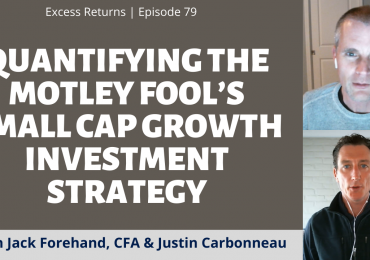Every other issue of The Validea Hot List newsletter examines in detail one of John Reese’s computerized Guru Strategies. This latest issue looks at the James O’Shaughnessy-inspired strategy, which has averaged 10.8% annualized returns since its inception nearly eight years ago, over a period in which the S&P 500 has returned 4% per year. Below is an excerpt from today’s newsletter, along with several top-scoring stock ideas from the O’Shaughnessy-based investment strategy.
Taken from the April 29, 2011 issue of The Validea Hot List
Guru Spotlight: James O’Shaughnessy
To say that James O’Shaughnessy has written the book on quantitative investing strategies might be an exaggeration — but not much of one. Over the years, O’Shaughnessy has compiled an anthology of research on the historical performance of various stock selection strategies rivaling that of just about anyone. He first published his findings back in 1996, in the first edition of his bestselling What Works on Wall Street, using Standard & Poor’s Compustat database to back-test a myriad of quantitative approaches. He has continued to periodically update his findings since then, and today he also serves as a money manager and the manager of several Canadian mutual funds.
In addition to finding out how certain strategies had performed in terms of returns over the long term, O’Shaughnessy’s study also allowed him to find out how risky or volatile each strategy he examined was. So after looking at all sorts of different approaches, he was thus able to find the one that produced the best risk-adjusted returns — what he called his “United Cornerstone” strategy.
The United Cornerstone approach, the basis for my O’Shaughnessy-based Guru Strategy, is actually a combination of two separate models that O’Shaughnessy tested, one growth-focused and one value-focused. His growth method — “Cornerstone Growth” — produced better returns than his “Cornerstone Value” approach, and was a little more risky. The Cornerstone Value strategy, meanwhile, produced returns that were a bit lower, but with less volatility. Together, they formed an exceptional one-two punch, averaging a compound return of 17.1 percent from 1954 through 1996, easily beating the S&P 500s 11.5 percent compound return during that time while maintaining relatively low levels of risk.
That 5.6 percent spread is enormous when compounded over 42 years: If you’d invested $10,000 using the United Cornerstone approach on the first day of the period covered by O’Shaughnessy’s study, you’d have had almost $7.6 million by the end of 1996 — more than $6.6 million more than you’d have ended up with if you’d invested $10,000 in the S&P for the same period! That seems powerful evidence that stock prices do not — as efficient market believers suggest — move in a “random walk,” but instead, as O’Shaughnessy writes, with a “purposeful stride.”
Two-In-One
Let’s start with O’Shaughnessy’s value stock strategy. His Cornerstone Value approach targeted “market leaders” — large, well-known firms with sales well above those of the average company — because he found that these firms’ stocks are considerably less volatile than the broader market. He believed that all investors-even the youngest of the bunch — should hold some value stocks.
To find these firms, O’Shaughnessy required stocks to have a market cap greater than $1 billion, a number of shares outstanding greater than the market mean, and trailing 12-month sales that were at least 1.5 times the market mean.
Size and market position weren’t enough to make a value stock attractive for O’Shaughnessy, however. Another key factor that was a great predictor of a stock’s future, he found, was cash flow. My O’Shaughnessy-based value model calls for companies to have cash flows per share greater than the market average.
O’Shaughnessy found that, when it came to market leaders, another criterion was even more important than cash flow: dividend yield. He found that high dividend yields were an excellent predictor of success for large, well-known stocks (though not for smaller stocks); large market-leaders with high dividends tended to outperform during bull markets, and didn’t fall as far as other stocks during bear markets. The Cornerstone Value model takes all of the stocks that pass the four aforementioned criteria (market cap, shares outstanding, sales, and cash flow) and ranks them according to dividend yield. The 50 stocks with the highest dividend yields get final approval.
The Cornerstone Growth approach, meanwhile, isn’t strictly a growth approach. That’s because one of the interesting things O’Shaughnessy found in his back-testing was that all of the successful strategies he studied — even growth approaches — included at least one value-based criterion. The value component of his Cornerstone Growth strategy was the price/sales ratio, a variable that O’Shaughnessy found — much to the surprise of Wall Street — was the single best indication of a stock’s value, and predictor of its future.
The Cornerstone Growth model allows for smaller stocks, using a market cap minimum of $150 million, and requires stocks to have price/sales ratios below 1.5. To avoid outright dogs, the strategy also looks at a company’s last five years of earnings, requiring that its earnings per share have increased each year since the first year of that period.
The final criterion of this approach is relative strength, the measure of how a stock has performed compared to all other stocks over the past year. A key part of why the growth stock model works so well, according to O’Shaughnessy, is the combination of high relative strengths and low P/S ratios. By targeting stocks with high relative strengths, you’re looking for companies that the market is embracing. But by also making sure that a firm has a low P/S ratio, you’re ensuring that you’re not getting in too late on these popular stocks, after they’ve become too expensive.
To apply the RS criterion, the Cornerstone Growth model takes all the stocks that pass the three growth criteria I mentioned (market cap, earnings persistence, P/S ratio) and ranks them by RS. The top 50 stocks then get final approval.
The Growth/Value Investor model I base on O’Shaughnessy’s two-pronged approach has been a very solid performer since its inception back in 2003, with my 10-stock O’Shaughnessy-based portfolio gaining 121.8% (10.8% annualized) since inception, while the S&P 500 has gained just 35.5% (4.0% annualized; figures through April 27).
The O’Shaughnessy-based portfolio will pick stocks using both the growth and value methods I described above. It picks whatever the best-rated stocks are at the time, regardless of growth/value distinction, meaning the portion of the portfolio made up of growth and value stocks can vary over time. As it has for some time now, the portfolio is currently finding more buys using the growth approach, which is responsible for picking eight of the stocks in the 10-stock portfolio. It’s also finding a lot of strong picks in two areas in particular: retail and healthcare. Here’s a look at the portfolio’s holdings (growth/value distinction in parentheses):
ROST — Ross Stores, Inc. (Growth)
HS — HealthSpring, Inc. (Growth)
TJX — The TJX Companies, Inc. (Growth)
INT — World Fuel Services Corporation (Growth)
SNY — Sanofi-Aventis SA (Value)
AZN — AstraZeneca PLC (Value)
HOGS — Zhongpin Inc. (Growth)
CHSI — Catalyst Health Solutions, Inc. (Growth)
AAP — Advance Auto Parts, Inc. (Growth)
BIG — Big Lots, Inc. (Growth)







